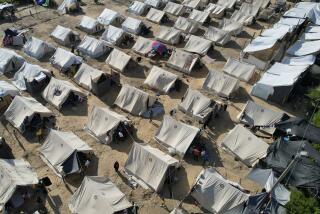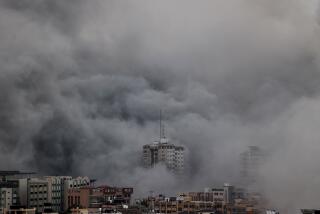Residents Flee to the Nile--or to Grassy Highway Dividers : Cairo in August: A Crowded, Polluted Oven
- Share via
CAIRO — If T.S. Eliot had been Egyptian, he might have written that August, not April, is the cruelest month.
Overcrowded, noisy and polluted, Cairo is not an easy place in which to live in any season. But come August, when the desert heat beats down upon the sweltering streets, living in Cairo is like being inside an oven in which the contents of all the ashtrays and wastepaper baskets in the house have been placed and set to broil.
Life during the summer moves at an even slower pace than usual. There are bursts of activity--in the early mornings and evenings--when the wind from the desert still blows gently and cool. Old men and boys are the first to appear in the mornings, hauling ice carts and buckets of water to quench the thirst of the commuters surging into the city center on their way to work.
But by early afternoon, when the wind turns blast-furnace hot and the temperature has begun its daily ascent past 100 degrees Fahrenheit, most Cairenes take refuge in their homes, where--shutters closed against the sun--they eat long meals and sleep away the afternoon.
Many Take Vacations
Those who can leave the city during August. The rich take vacations in Europe while the middle class trade the shoulder-to-shoulder chaos of Cairo’s teeming streets for the crowded beaches of Alexandria, on the Mediterranean.
But, if there is one virtue that Cairenes of all classes share--perhaps in greater measure than the residents of any other major metropolis--it is their ability to cheerfully make the best of the worst situation. So those who can’t leave Cairo in the summer--and that includes most people--occupy virtually every strip of green still extant in their congested capital.
“Yes, we come here every year,” said Mohammed Salah, as though he were talking about summering in the Hamptons. But the Salah family’s vacation spot is a somewhat mangy patch of grass under a grit-caked palm tree on a highway divider near Cairo Airport.
Armed with portable radios, lawn chairs and soccer balls, thousands of families stake out spots on these well-trodden dividers to while away the summer evenings with seeming indifference to the strident blare of horns and the thick exhaust fumes of the bumper-to-bumper traffic on either side.
Flock to Nile
On weekends, Cairenes flock by the thousands to Zamalek, an island in the middle of the Nile, to spend their afternoons sitting and sipping tea from under the shade of dusty trees as they watch the river traffic slip by.
There is one old man who returns to the same spot along the Nile every summer. He usually carries a newspaper but rarely seems to read it. He just sits there alone and stares at the low line of buildings running along the opposite shore like a rambling sentence, punctuated by the minarets that rise like exclamation points into the sky.
In the summer, children swim in the Nile’s sluggish waters and women wash their clothes in it. Occasionally, a speed boat zips by, towing a water skier in its frothy green wake. There is only one fully functioning sewage treatment plant in all of Cairo--and in all of Egypt, for that matter--and the Nile is badly polluted with both human and industrial waste.
Government officials, perhaps because they are embarrassed at having done little about it, do not admit that pollution is a major problem. But this does not lessen the impression that most visitors have of Cairo as one of the world’s dirtiest cities.
On most days, a fine yellowish veil of dust from the desert and cement powder from the factories in the giant industrial suburb of Helwan envelops the city, reddening the eyes and imparting a pasty taste to the mouth. It rarely rains in Cairo, but when it does the rainwater lies in oily black pools until it evaporates.
Shortly after the Chernobyl nuclear accident in the Soviet Union, a prominent Egyptian scientist was asked about the danger of radioactive fallout’s reaching Egypt. “So what if it does?” he replied. “It will be nothing compared to Cairo’s pollution.”
Overcrowding, Poor Planning
Pollution, like most of Cairo’s problems, is the result of overcrowding made worse by poor planning. Cairo is a city built for 2 million people that, by conservative estimates, is home to at least 14 million. The vast majority live in what is delicately referred to here as “informal housing”--the tens of thousands of shacks and hovels, most of them without sewers, running water or electricity, which form a vast girdle of slums around Cairo’s ever-expanding waistline. Nearly 80% of Cairo’s housing is said to be “informal.”
“Cairo is like an overflowing cup,” said Hassan Fathy, Egypt’s most famous architect. “The proper density for our residential areas should be no more than 80 to 90 people per acre. We have 10,000.”
Three years ago, an international symposium was held to discuss Cairo’s urban and environmental problems. There were dire warnings and detailed proposals and much lamenting of the fact that Cairo is no longer the grand city, the mecca for intellectuals and the inspiration to poets, that it used to be.
‘Beauty Has Left It’
“Cairo is fast growing old,” Kamal Abdul Magd, a well known Egyptian jurist, told the conference. “Greenness has abandoned this city and beauty has left it. . . . Putrid waters and massive heaps of trash obstruct the roads. . . . Dwellings and factories have become interlocked in a dreadful discord.”
The symposium produced much talk but, in the end, little action.
But, for all this, things are slowly improving. Although newcomers are shocked by Cairo’s poverty and the obvious inadequacies of its antique infrastructure, former residents returning after several years frequently remark how much things have improved since they lived here. There are fewer potholes in the streets and fewer pools of open sewage, and the traffic now moves at a crawl. Cairo has a new airport and several more hotels, and it will soon complete work on its first subway line.
And there is still a vitality and vibrancy, a special kind of magnetism, about Cairo that continues to attract hordes of summer visitors from the Persian Gulf and other Arab countries.
The “Gulfies,” as they are commonly called, come every August to revel in the seedy sensuality of Cairo’s night life, to gamble in its casinos and order whiskey by the bottle at the nightclubs as they watch writhing belly dancers perform--all pleasures forbidden to them at home.
Openness, Warmth
Most important, however, Egyptians still possess an openness and genuine warmth that makes them among the nicest and most hospitable people on earth.
“We have a saying,” an Egyptian intellectual said, “that our people are like a noble horse. No matter how mean the rider and how hard he whips us, we keep plodding on.”
Indeed, whenever foreigners--diplomats, journalists and businessmen--start discussing Egypt’s future, their predictions usually fall into one of two categories. There are those who, aghast at the magnitude of the problems, see social upheaval in the offing; they are the proponents of the “apocalypse” theory. Then there are those who, having been here longer, believe that Egyptians, like the noble horse, will continue to plod along, come what may; they believe in what is popularly known as the “muddle through” theory.
More than likely, the truth is somewhere in between. Someday, Egypt’s apocalypse will arrive--and somehow Egyptians will find a way of muddling through it.
More to Read
Sign up for Essential California
The most important California stories and recommendations in your inbox every morning.
You may occasionally receive promotional content from the Los Angeles Times.













